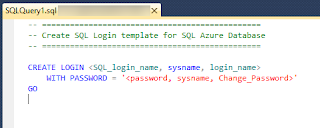This week i had to create a few new users for a SQL Azure database. I have to do this often, but I can never remember the exact steps that need to be run.
If you've connected to a SQL Azure instance, you'll quickly see that some of the useful UI Options don't exist or work differently. For example, if you want to add a new user, you get a SQL script that just creates the user, but doesn't give them any access to the database:

SQL:

In order to actually give the user access to a database, you need to switch your connection to the database you want to the user to access and run the following command:
If you've connected to a SQL Azure instance, you'll quickly see that some of the useful UI Options don't exist or work differently. For example, if you want to add a new user, you get a SQL script that just creates the user, but doesn't give them any access to the database:

SQL:

In order to actually give the user access to a database, you need to switch your connection to the database you want to the user to access and run the following command:
CREATE USER [UserName]
FOR
LOGIN [UserName]
WITH
DEFAULT_SCHEMA = dbo
GO
-- Add user to the
database owner role
EXEC
sp_addrolemember N'db_owner', N'[UserName]'
GO
You can switch out the default schema and role to whatever fits your needs.
After all of that, the user should work, but if you try to connect from SQL Mgmt Studio, you'll get an error that the user does not have access to the Master database. If this wasn't SQL Azure, we could set the default database and we'd be set, but SQL Azure doesn't support that (yet) so we need have 2 options:
Option 1: Give the user Access to the master database:
This can be done by running the "Create User" script from above but on the master database
Option 2: Pick the specific database from SQL Mgmt Studio.
For this option, when you try a new connection to a SQL server, click the "options" button in the lower right of the screen:
Then type in the name of the database and click Connect:
Done!


Appreciating the persistence you put into your blog and detailed information you provide.
ReplyDeletevery nice blog it was useful.
MS Azure Online Training